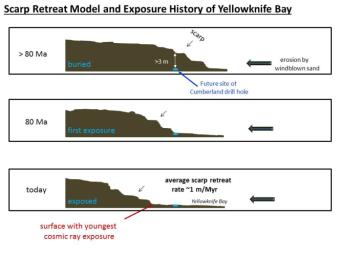
|
Scarp Retreat Model and Exposure History of ‘Yellowknife Bay’
- Click the image above for a larger view
- Full-Res JPEG (960 x 720) (64.4 kB)
- Full-Res TIFF (960 x 720) (2.1 MB)
Caption:
This set of drawings depicts cross sections of the "Yellowknife Bay" area of Mars' Gale Crater at three points in time going back more than 80 million years (>80 Ma).
NASA's Curiosity Mars rover has made measurements indicating that the Cumberland rock target the rover drilled in May 2013 has been exposed at the surface for about 80 million years. Further ago than that, the drill site was covered with about 10 feet (3 meters) of rock, as depicted in the top panel. At about 80 million years (middle panel), Cumberland was exposed as the scarp retreated due to abrasion by windblown sand. The sideways erosion, or retreat, occurred at an average rate of about 3 feet (1 meter) per million years.
This pattern suggests that the material with the youngest surface-exposure age and lowest cosmic-ray dose is at the base of the downwind scarp. Understanding the pattern gives the rover team insight for selecting future targets for drilling to investigate whether organic chemicals have been preserved in rocks.
Background Info:
NASA's Jet Propulsion Laboratory, Pasadena, Calif., manages the Mars Science Laboratory Project and the mission's Curiosity rover for NASA's Science Mission Directorate in Washington. The rover was designed and assembled at JPL, a division of the California Institute of Technology in Pasadena.
More information about Curiosity is online at http://www.nasa.gov/msl and http://mars.jpl.nasa.gov/msl/ .
Cataloging Keywords:
| Name | Value | Additional Values |
|---|---|---|
| Target | Mars | |
| System | ||
| Target Type | Planet | |
| Mission | Mars Science Laboratory (MSL) | |
| Instrument Host | Curiosity Rover | |
| Host Type | Rover | |
| Instrument | ||
| Detector | ||
| Extra Keywords | Color, Crater | |
| Acquisition Date | ||
| Release Date | 2013-12-09 | |
| Date in Caption | ||
| Image Credit | NASA/JPL-Caltech | |
| Source | photojournal.jpl.nasa.gov/catalog/PIA17604 | |
| Identifier | PIA17604 | |
